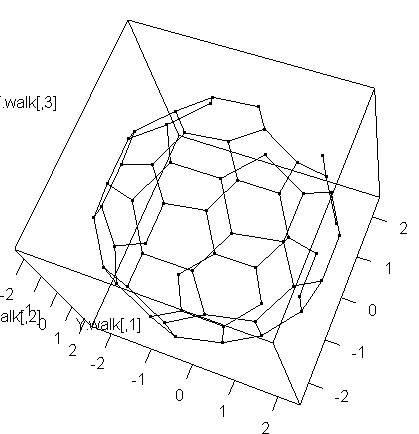- 昨日は平面に正六角形を敷き詰めてself-avoiding pathを描いた
- 今日は、元の話題に戻って、サッカーボール・フラーレン上にしよう
- サッカーボールは正20面体のすべての面(正三角形)の角を落として正六角形を残したものなので、まずは正20面体を作る

G <- (1+sqrt(5))/2
g1 <- c(1,G,0)
g2 <- c(-1,G,0)
g3 <- c(1,-G,0)
g4 <- c(-1,-G,0)
X1 <- matrix(c(g1,g2,g3,g4),byrow=TRUE,ncol=3)
X2 <- X1
X2[,1] <- X1[,2]
X2[,2] <- X1[,3]
X2[,3] <- X1[,1]
X3 <- X2
X3[,1] <- X2[,2]
X3[,2] <- X2[,3]
X3[,3] <- X2[,1]
X <- rbind(X1,X2,X3)
X <- X/2
D <- as.matrix(dist(X))
D[upper.tri(D)] <- 0
E <- which(D==1,arr.ind=TRUE)
plot3d(X)
for(i in 1:length(E[,1])){
segments3d(X[E[i,],])
}
- サッカーボール座標
- 正20面体のすべての辺を三等分する点を結んだのがサッカーボール座標
- 頂点座標を求めた後、頂点ペアのうち距離が最小になるものがエッジ
- エッジは2種類ある。6角形の2面にはさまれるエッジと6角形と5角形とにはさまれるそれ
- 6角形にはさまれるエッジは、それが連結する頂点において、2本のエッジと120度で交叉するのに対し、6角形・5角形にはさまれるエッジは頂点での交叉角が120,108と等しくない。これを利用してエッジの色を塗り分ける

Y <- matrix(0,60,3)
cnt <- 1
for(i in 1:length(E[,1])){
tmp <- X[E[i,],]
Y[cnt,] <- tmp[1,]/3 + tmp[2,]/3*2
cnt <- cnt + 1
Y[cnt,] <- tmp[2,]/3 + tmp[1,]/3*2
cnt <- cnt + 1
}
D.Y <- dist(Y)
Y <- Y/min(D.Y)
D.Y <- as.matrix(dist(Y))
D.Y[upper.tri(D.Y)] <- 0
E.Y <- which(abs(D.Y-1)<10^(-3),arr.ind=TRUE)
library(igraph)
g <- graph.edgelist(E.Y)
ad.edge <- get.adjedgelist(g)
edge.vector <- matrix(0,length(E.Y[,1]),3)
for(i in 1:length(E.Y[,1])){
edge.vector[i,] <- apply(Y[E.Y[i,],],2,diff)
}
e.type <- rep(1,length(E.Y[,1]))
for(i in 1:length(ad.edge)){
tmp <- edge.vector[ad.edge[[i]],]
tmp2 <- tmp%*%t(tmp)
diag(tmp2) <- 0
tmp2 <- abs(tmp2)
for(j in 1:length(ad.edge[[i]])){
tmp3 <- tmp2[j,which((1:3)!=j)]
if(diff(range(tmp3))<10^(-2)){
e.type[ad.edge[[i]][j]] <- 2
}
}
}
plot3d(Y)
for(i in 1:length(E.Y[,1])){
segments3d(Y[E.Y[i,],],col=e.type[i])
}
- まずはルールなき酔歩をしてみよう、行きつ戻りつもあり

adj.m <- as.matrix(get.adjacency(g))
adj.m <- adj.m + t(adj.m)
n.iter <- 400
v.hx <- rep(0,n.iter)
v.hx[1] <- sample(1:60,1)
v.hx[2] <- sample(which(adj.m[v.hx[1],]==1),1)
for(i in 3:n.iter){
cand <- which(adj.m[v.hx[i-1],]==1)
v.hx[i] <- sample(cand,1)
}
Y.walk <- Y[v.hx,]
plot3d(Y.walk)
for(i in 1:(length(Y.walk[,1])-1)){
segments3d(Y[c(v.hx[i],v.hx[i+1]),])
adj.m <- as.matrix(get.adjacency(g))
adj.m <- adj.m + t(adj.m)
n.iter <- 400
v.hx <- rep(0,n.iter)
v.hx[1] <- sample(1:60,1)
v.hx[2] <- sample(which(adj.m[v.hx[1],]==1),1)
for(i in 3:n.iter){
cand <- which(adj.m[v.hx[i-1],]==1)
v.hx[i] <- sample(cand,1)
}
Y.walk <- Y[v.hx,]
plot3d(Y.walk)
for(i in 1:(length(Y.walk[,1])-1)){
segments3d(Y[c(v.hx[i],v.hx[i+1]),])
}
adj.m.edgeid <- adj.m
for(i in 1:length(E.Y[,1])){
adj.m.edgeid[E.Y[i,1],E.Y[i,2]] <- i
adj.m.edgeid[E.Y[i,2],E.Y[i,1]] <- i
}
n.iter <- 2000
v.hx <- rep(0,n.iter)
v.visit <- rep(0,60)
e.hx <- e.type.hx <- rep(0,n.iter-1)
v.hx[1] <- sample(1:60,1)
v.hx[2] <- sample(which(adj.m.edgeid[v.hx[1],]>0),1)
e.hx[1] <- adj.m.edgeid[v.hx[1],v.hx[2]]
e.type.hx[1] <- e.type[e.hx[1]]
v.visit[v.hx[2]] <- 1
cnt <- 3
for(i in 3:n.iter){
print(i)
print(v.hx[i-1])
cand.v <- which(adj.m.edgeid[v.hx[cnt-1],]>0)
cand.e <- adj.m.edgeid[v.hx[cnt-1],cand.v]
cand.e.type <- e.type[cand.e]
if(e.type.hx[cnt-2]==1){
tmp <- which(cand.e.type==2)
if(v.visit[cand.v[tmp]]==1){
cnt <- cnt-2
print("---")
print(i)
v.visit[v.hx[cnt-1]]<-0
v.hx[(cnt-1)] <- 0
e.hx[cnt-2] <- 0
e.type.hx[cnt-2] <- 0
}else{
v.hx[cnt] <- cand.v[tmp]
v.visit[v.hx[cnt]] <- 1
e.hx[cnt-1] <- cand.e[tmp]
e.type.hx[cnt-1] <- 2
}
}else{
cand.v2 <- which(adj.m.edgeid[v.hx[cnt-1],]>0)
print(cand.v2)
sh.cand.v2 <- sample(cand.v2)
tmp <- sh.cand.v2[1]
if(v.visit[tmp]==1){
print("&&&")
cnt <- cnt-1
print(i)
}else{
v.hx[cnt] <- tmp
v.visit[v.hx[cnt]] <- 1
e.hx[cnt-1] <- adj.m.edgeid[v.hx[cnt-1],tmp]
e.type.hx[cnt-1] <- 1
}
print(i)
}
cnt <- cnt+1
if(v.hx[cnt] == v.hx[1]){
break
}
}
if(v.hx[cnt]==0){
cnt <- cnt-1
}
v.hx.1 <- v.hx[1:cnt]
plot3d(Y[v.hx.1,])
for(i in 1:(length(v.hx.1)-1)){
col <- e.type.hx[i]
segments3d(Y[c(v.hx.1[i],v.hx.1[i+1]),],col=e.type.hx[i])
}


